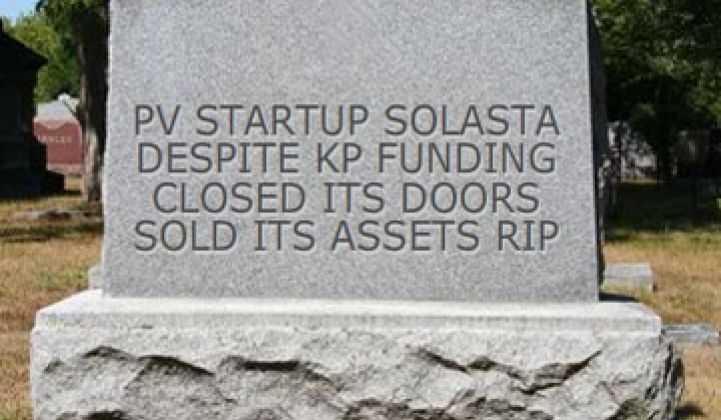We're starting to see the beginning of attrition in the scores of VC-funded solar startups. Last year we lost Optisolar and SV Solar, this year we saw the demise of Senergen. Add to that list of former solar startups the Kleiner Perkins-funded Solasta. The shuttering of Solasta was rumored earlier this year, but here's a statement provided to Greentech Media from the former CTO, Michael Naughton:
"After a reassessment of the thin-film solar market by its venture capital investors, Solasta has shut down. It has executed a sale of its assets, consisting of laboratory-scale solar cell fabrication and characterization equipment, and intellectual property. The former includes a license to the original nanocoax solar technology, still held by Boston College, as well as additional IP generated by the company. It has been sold to an academic institution in China which plans to continue development toward commercialization. The company also terminated an active $2.7 million grant from the Department of Energy's Solar Energy Technology Program.
Scientists at Solasta and Boston College, in collaboration with the IMT at EPFL in Neuchatel, Switzerland, have recently published a paper on the nanocoax solar cell in Physica Status Solidi. The paper is the topic of the cover of the July/August 2010 issue of this journal."
Lessons from this:
- Getting VC funding for a Round B or C, absent customers or revenue, remains a daunting task even if you have Kleiner Perkins as an initial investor and a DOE grant.
- It didn't help that the firm was focused on improving the efficiency of amorphous silicon, a challenged technology sector in the thin film space (see AMAT's SunFab business).
- The firm's business plan emphasized licensing the technology, not always the preferred strategy for venture firms like KPCB.
The wrenching process of startup closure is a difficult and inevitable part of the innovation culture in the United States. The investors will go on to fund more companies and the entrepreneurs will continue to innovate.
***
(This is a condensed version of the article I wrote about Solasta back in March.)
"Separating the path of the photons from the path of the generated charge carriers."
"Decoupling the optical and electronic pathways."
That's what Solasta was trying to do.
The Newton, Mass.-based solar firm was founded in 2006 with A round funding from Kleiner Perkins. Solasta also received more than $3 million in two DOE grants.
With technology and founding personnel in the form of three physics professors from Boston College (Michael J. Naughton, CTO, Zhifeng Ren and Krzysztof Kempa), Solasta was using amorphous silicon and carbon nanotubes on a glass substrate in an attempt to create more efficient solar cells that are simple and inexpensive to manufacture.
Solasta was helmed by former KPCB Executive-in-Residence Mike Clary who has led other advanced technology companies such as GMZ Energy and Nanostar. He appears to have returned to the venture firm.
According to the executive summary in a February 2009 DOE report, Solasta:
"Provides a photovoltaic medium with independent optical and electronic pathways, separating the photo from the voltaic with respect to required thickness of photovoltaic absorber material. It does so with innovations in both light and charge collection."
The amorphous-silicon "nanocoax" structure increases current and potentilally lowers materials cost. The company (which is hiring engineers) claims the process could increase the efficiency of conventional amorphous silicon PV by up to 150 percent.
CTO Naughton further explained Solasta's process in an email:
"In contrast to the numerous nanowire solar cell approaches under development, Solasta's Nanocoax, which is literally a nanoscale coaxial cable (think cable TV), requires photogenerated electrons and holes to travel only nanoscopic distances before reaching metallic electrodes. This significantly lowers carrier recombination, allowing more current to get out, and thus higher efficiency, even for noncrystalline materials like (but not restricted to) a-Si. Light collection is controlled by the Nanocoax vertical height, while the charge travels short distances horizontally (radially). This separation of the 'photo-' from the '-voltaic' solves the thick-vs.-thin conundrum of solar power, and allows Solasta to use films even thinner than 'thin film,' further lowering cost and weight."
A startup with a new technology in solar can try to become a PV panel supplier like Solyndra or Nanosolar – but that takes hundreds of millions of dollars, could take a decades and cost thousands of innocent lives. The company could try to go the route that 1366 Technologies is trying – selling add-on processes that fits into existing manufacturing schemes. Or a startup can license its technology and that was currently Solasta's vision.
I spoke with the CEO and CTO. "We look to license the technology to enable a step up in efficiency and to allow companies to differentiate," Clary said. Clary also envisioned a "software model" for the license, where successive generations of the Solasta technology would continue to flow through through their licensees.
Naughton added that this was "an architecture, not a materials process," and that the firm was "not at all restricted to a-Si."



